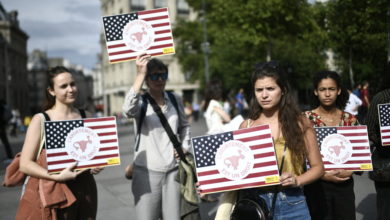Police Problems in Grand Rapids Before Patrick Lyoya

TGrand Rapids has been the scene of demonstrations over the past week. Police released video last Wednesday showing a white officer shooting at a Black man in his back. The incident and the community’s expression of unhappiness are one more chapter in the story of recent protest that began when a Minneapolis police officer murdered George Floyd by kneeling on his neck in 2020.
But experts on Grand Rapids history note that for Michigan’s second largest city—which is about two-thirds white and 20% Black—this story is much more than two years old.
Grand Rapids, like many Midwestern towns, has a progressive image which hides deep-seated issues for Black residents.
“People joke sometimes, calling it Bland Rapids because of its similarity to all the other cities,” says Randal Maurice Jelks, author of African Americans in Grand Rapids’ Furniture City: The Struggle for Civil Rights. “And people have the saying ‘Grand Rapids nice,’ which means that people, on the surface, appear courteous, and on the back end, are quite exclusionary.”
Continue reading: George Floyd’s Death and the Long History of Racism in Minneapolis
“Progressive imagery permitted racism to hide in plain sight for decades,” Todd Robinson, historian and author of Grand Rapids, Michigan: A city within a city. The Black Freedom Struggle. TIME via an email. “In 1949, Grand Rapids received the first of three (1960 and 1981) National Civic League ‘All American City’ awards while maintaining a thoroughly racialized landscape through redlining, discriminatory lending policies, and racial steering. These practices further widened the wealth, housing, educational, and social gap between white and Black residents.”
Robinson argues that segregation created a “city within a city” in Grand Rapids, in which “over-policing [of] predominantly Black enclaves” was used to preserve the whiteness of other areas.
As the city’s Black population grew after World War II, with new residents heading to work for companies like General Motors, so did police presence in their communities.
“Many Black people left the South because of the changing agricultural economy, as cotton picking went automated, looking for better wages—and those wages were thought to be in factories and auto industries,” says Jelks. “And one way of dealing with Black communities [for the cities in which they arrived] was to heavily police them, and that became a problem.”
Continue reading: History is changing because of the forgotten girls who left the South.
This problematic relationship was protested before.
It was actually a traffic incident that brought the city to its knees more than 50-years ago. The summer of 1967 earned the nickname “the long, hot summer” for violent upheaval that took place in many American cities triggered by continued racial injustice. In July 1967, a three-day demonstration erupted at Grand Rapids after police used excessive force to stop an African American teenager.
There were also increased tensions after the Vietnam War. After fighting in two wars, the Korean War, and the Vietnam War, the city’s Black Americans—like many across the country and the world—pointed out the irony of being sent to supposedly defend freedom abroad while they still had to fight for freedom in the U.S. “They’re not up for being bossed around and being told what to do by the police, because they too had in essence the same training as many police officers had by being veterans,” says Jelks.
Continue reading: Black Vietnam Veterans recall the Injustices they Faced during and after the War
Nearly 180 African Americans were detained during the 1967 rebellion, but no significant policy changes occurred. As Robinson explains of the fallout, “The arrests did nothing to address African Americans’ concerns regarding the entangled histories of race, poverty, and segregation. It did, however, further the over-policing of Black neighborhoods and deepened systemic inequities and implicit biases within the local white community.”
To Robinson, the tensions and protests of this month are in many ways an outgrowth of the “constant neglect” of that history of discrimination.
Here are more must-read stories from TIME





